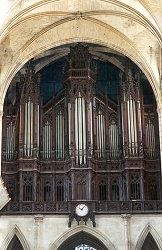  The Nineteenth Century
|
| As had every century before it, the nineteenth century had its times of peace and of war, its struggles and triumphs, its plateaus of complacency and its peaks of change. In spite of these similarities, though, the nineteenth century stands out for several reasons, some of them isolated in their impact, others universal.
The "peaceful revolution" -- the Industrial one -- eventually made the greatest impact on organ building. In France, Germany, England -- even in North America -- organs were built in factories -- large industrial concerns that employed many people and machines doing the work that had previously been done by a small number of artisans. Bound up in this new way of doing the job was a new way of looking at the instrument, and by the end of the century new solutions to mechanical problems lead the way to radical changes in the concept of what an organ should be like as a musical instrument. These two elements, then, characterize the organ of the nineteenth century:
Although the earlier pages of this tutorial are limited to describing organs in churches, you'll find that limitation eroding during the nineteenth century. The increasingly avid audience of the nineteenth century provided a force that prompted not only the building of civic and municipal concert halls, but also the erection of concert organs within them. In fact, it's not stretching the truth to say that some of the most notable instruments of the period -- in the Trocadero in Paris and in Birmingham's Town Hall, for example -- were built not in churches but in public concert halls. We must add "place," then to the changes made in organ building during the nineteenth century. All in all, the nineteenth century saw change everywhere, and these changes produced different results at the hands of diffrent builders. Even so, you can still look at and listen to different organs from the nineteenth century and find national traits revealed in them.
As I am wont to do at every opportunity, I ask you to look at each of the instruments described on the accompanying pages and consider it as a unique creation. Think of its place in history, how it relates to its own past, how it is innovative -- all of those things, to be sure. But also think of it as it must have been used, think about the music that was played on it, the way it fits into the overall music culture of the nineteenth century. The possibilities each instrument offered for musical creation form one of its most important legacies. Enjoy the trip through history these instruments can give you. As you have with instruments from other centuries, think about each one's disposition, its mechanics, its appearance. But now, add to those thoughts a consideration of the building and its purpose. Ask yourself "where" the instrument was installed and consider its other attributes as they relate to place. Above all, listen with your mind's ear to the music written for each one, both in general and in particular, and remember that these marvelous, innovative machines were -- and in many cases still are -- great musical instruments. © 2001 AD James H. Cook |